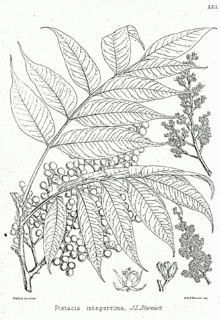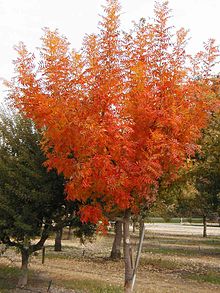Pistachios
| Pistachios | ||||||||||||
|---|---|---|---|---|---|---|---|---|---|---|---|---|

Inflorescence of a male turpentine pistachio ( Pistacia terebinthus ) |
||||||||||||
| Systematics | ||||||||||||
|
||||||||||||
| Scientific name | ||||||||||||
| Pistacia | ||||||||||||
| L. |
The pistachios ( Pistacia ) are a genus of plants with about ten to twelve species from the sumac family (Anacardiaceae). They occur in the northern hemisphere in Asia as well as in Europe and America. Some species are used to obtain pistachios .
features


The pistachio species are trees and shrubs . The alternate leaves are usually pinnate , paired or unpaired, sometimes in three parts , rarely undivided. The leaves or leaflets have a smooth edge. Stipules are missing.
They are dioeciously separated sexes ( diocese ). Many flowers stand together in axillary , racemose or panicle inflorescences . The small flowers are unisexual. The male flowers have a simple perianth without petals and no disc , three to six, rarely seven, stamens with short stamens and large, egg-shaped anthers and a reduced or no gynoceum . By bracts sheathed female flowers contain a two- to five-piece, simple perianth without petals, the short stylus ends in three outstretched scars, a discus is missing or reduced, missing Staminodien, the ovary is upper constant, unicompartmental with a single ovule .
A solitary stone fruit is formed, which turns red and is spotted when ripe. The seeds have no endosperm .
distribution


The pistachio species occur in the Mediterranean area , southwest and east Asia , southern North America and in Guatemala .
Systematics
The genus name Pistacia was first published in 1753 by Carl von Linné in Species Plantarum , 2, pp. 1025-1026. Type species is Pistacia vera L. A synonym for Pistacia is Terebinthus Mill.
There are around ten to twelve types of Pistacia :
- Pistacia aethiopica Kokwaro : This species is native to Ethiopia , Kenya , Somalia , Tanzania , Uganda and Yemen .
- Atlantic pistachio , terebinth or Atlantic terebinth ( Pistacia atlantica Desf. ): The home is the Mediterranean area, Asia Minor and the Indian subcontinent.
- Pistacia chinensis Bunge : The home is China , Taiwan and the Philippines . The wood is used to make furniture and to produce a yellow dye.
- Pistacia cucphuongensis Dai : It is endemic to Cuc Phuong and Ninh Binh in Vietnam .
- Pistacia eurycarpa Yalt. : The homeland ranges from Asia Minor to Afghanistan .
- Pistacia integerrima J. Stewart : The homeland ranges from Afghanistan and Myanmar to the Indian subcontinent.
- Pistacia khinjuk Stocks : The homeland ranges from Egypt to Asia Minor and Afghanistan to the Indian subcontinent.
- Mastic bush , wild pistachio ( Pistacia lentiscus L. ): useful plant for a natural resin, Mediterranean area
- Pistacia malayana M.R.Henderson : The home is Malaysia.
- Pistacia mexicana H.BK : The home is Guatemala and Mexico.
- Turpentine pistachio ( Pistacia terebinthus L. )
- Pistacia texana Swingle : The home is Texas and the northern Mexican states: Coahuila , Nuevo León , Tamaulipas .
- Real pistachio ( Pistacia vera L. ): The classic edible plant, originally from the Middle East and Central Asia
- Pistacia weinmannifolia J. Poisson ex Franch. : The home is China and Myanmar .
In addition the hybrid:
- Pistacia × saportae Burnat = Pistacia lentiscus × Pistacia terebinthus : It is a nature hybrid that is native to the Mediterranean.
Wood
The extremely attractive light-dark colored, hard and heavy, but easily workable wood of Pistacia vera is very valued in the turnery and in handicrafts. Knife handles in particular are made from it.
swell
- Tianlu Min & Anders Barfod: Anacardiacdeae in the Flora of China : Volume 11, p. 345: Pistacia - Online. accessed in March 2010 (section description)
Individual evidence
- ^ Klaus Kubitzki : The Families and Genera of Vascular Plants. Vol. X: Flowering Plants , Springer, 2011, ISBN 978-3-642-14396-0 , p. 10.
- ↑ a b c Yasin J. Nasir: Pistacia in Flora of Pakistan at efloras.org , accessed on February 16, 2008 (English).
- ↑ a b Pistacia at the TROPICOS database of the Missouri Botanical Garden (English).
- ↑ Entry with a complete species list.
- ↑ Pistacia aethiopica in the IUCN Red List of Threatened Species 2009.
- ↑ Tianlu Min & Anders Barfod: Anacardiacdeae in the Flora of China : Volume 11, p. 345: Pistacia - Online.
- ↑ Pistacia cucphuongensis in the IUCN Red List of Threatened Species 2009.
- ↑ Pistacia malayana in the IUCN Red List of Threatened Species 2009 ..
- ↑ Pistacia mexicana in the IUCN Red List of Threatened Species 2009 ..
further reading
- S. Kafkas & R. Perl-Treves: Interspecific relationships in Pistacia based on RAPD fingerprinting , in HortScience , 37, 2002, pp. 168-171.
Web links
- Pistacia at Plants for a Future . (English)